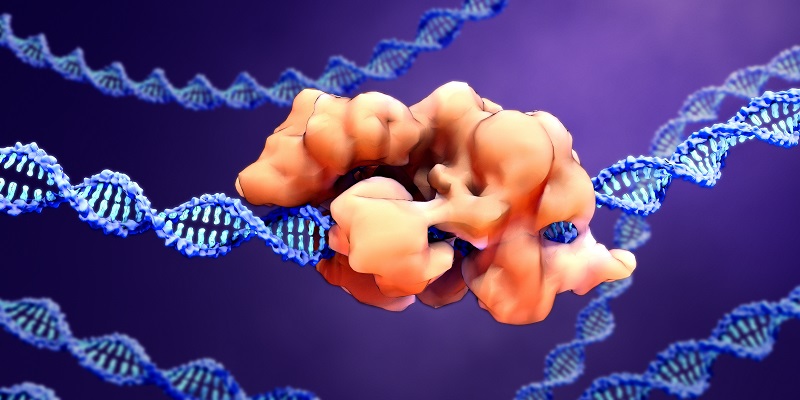Gene editing offers the potential to correct DNA mutations to treat or eliminate human diseases by changing the DNA of cells with single base pair precision. CRISPR-Cas9* is probably the best known among the variety of engineered nucleases that have been developed to increase gene editing efficiency and enable potential therapeutic applications.
CRISPR-Cas9 technology is based on a naturally occurring form of genome editing. Translated to the lab, this system uses the CRISPR-associated protein 9 (Cas9) enzyme bound to a guide RNA to locate and precisely cut a specific DNA sequence in the genome. This results in double-strand DNA breaks that are then repaired by homologous or non-homologous recombination.
The efficient treatment of complex diseases like some cancers may require the modification of several genes simultaneously by deleting or inserting multiple DNA sequences at once in the same cell. Therefore, incorporating multiple CRISPR guide sequences would permit, in theory, multiplex genome editing at multiple sites within a genome.
Adoptive Cell Therapy and Multiplex CRISPR-Cas9 Editing
The activation of the immune system is nowadays the most promising way to cure cancer. T lymphocytes are specialized immune cells that are largely at the core of the modern-day cancer immunotherapy revolution. They have the natural ability to fight cancer, with receptors that bind to structures recognized as non-self to trigger the immune system to engage in defense – provided that the tumor does not apply any brakes to inhibit immune activation. The proteins CTLA-4 and PD-1, for example, have been found to function as T cell brakes that when disengaged via immune checkpoint therapy can unleash the immune system’s ability to eliminate tumor cells even more efficiently.
Adoptive cell therapies (ACT) are one of the most promising areas of cancer immunotherapy. In these novel concepts, the patients are treated with lymphocytes that are retrieved from their own blood, genetically engineered ex-vivo and re-administered. These engineered lymphocytes express a synthetic (transgenic) T cell receptor (TCR) that can specifically detect and kill tumor cells.
In a research article published in the 6 February 2020 issue of Science, researchers from University of Pennsylvania led by Carl June demonstrated that the editing at several sites within the genome of human T lymphocytes was possible, thus enhancing their natural ability to kill cancer.
The genomic edits included:
- Deletion of a gene encoding PD-1 (PDCD1) to improve anti-tumor immunity.
- Deletion of two genes encoding the endogenous TCR chains, TCRα (TRAC) and TCRβ (TRBC).
- Lentiviral transduction of the CRISPR-edited T cells synthetic with a transgenic TCR specific for a peptide epitope present in the immunogenic tumor antigens NY-ESO-1 and LAGE-1.
The resulting triple-edited cells were termed “NYCE” (NY-ESO-1 transduced CRISPR 3x edited cells).
NYCE Results
Adoptive transfer of the engineered T cells into three patients with refractory cancer resulted in durable engraftment with edits at all three genomic loci. Bone marrow and tumor biopsy analysis revealed that the NYCE engineered cells were transported to the tumor sites in all patients. The NYCE also showed stable persistence for up to 9 months after infusion. PCR was used to evaluate the total number of vector copies per microgram of genomic DNA of the NY-ESO-1 TCR transgene in the peripheral blood, bone marrow, and tumor pre- and post-NYCE T cell infusion, as well as to determine the frequencies of CRISPR-Cas9-edited T cells following adoptive cell transfer. Flow cytometry was used to establish absolute numbers of NY-ESO-1 TCR-expressing T cells per milliliter of whole blood.
In addition to their long survival in the human body, the CRISPR-edited cells were shown also to have a sustained ability to attack and kill tumors in vitro, retaining anti-tumor function for a long period of time after a single infusion. This was demonstrated by measuring cytotoxicity of the CRISPR-edited cells in a chromium (51Cr) release assay.
No patient experienced treatment-induced cytokine release syndrome or other serious adverse events. However, no patients in this study responded to the therapy as of December 2019. It is pertinent to note though that the manufacturing technology of engineered T cells has progressed significantly since the IND of this trial was submitted and it is possible that gene-edited T cells manufactured using today’s methods may be more effective, increasing efficiencies and lowering off-target editing.
BioAgilytix Leads Gene & Cell Therapy Bioanalysis with Advanced Technology
Detection of modified T cell persistence was a fundamental assessment in the trial described above and requires the right platforms to ensure robust and timely analysis. To support our sponsors’ evolving study requirements, BioAgilytix continually assesses and invests in technology to accelerate and enhance our bioanalytical capabilities. As more customers turn their focus to the promising realm of gene and cell therapy development, we have significantly increased the instrumentation within our molecular testing suite to include real-time qPCR, digital droplet (dd)PCR, additional platforms for FACS analysis, and other innovative technologies for genomics testing. Learn more about our capabilities to support your study needs by scheduling a discussion with our team today.
* Clustered Regularly Interspaced Short Palindromic Repeats associated with Cas9 endonuclease
